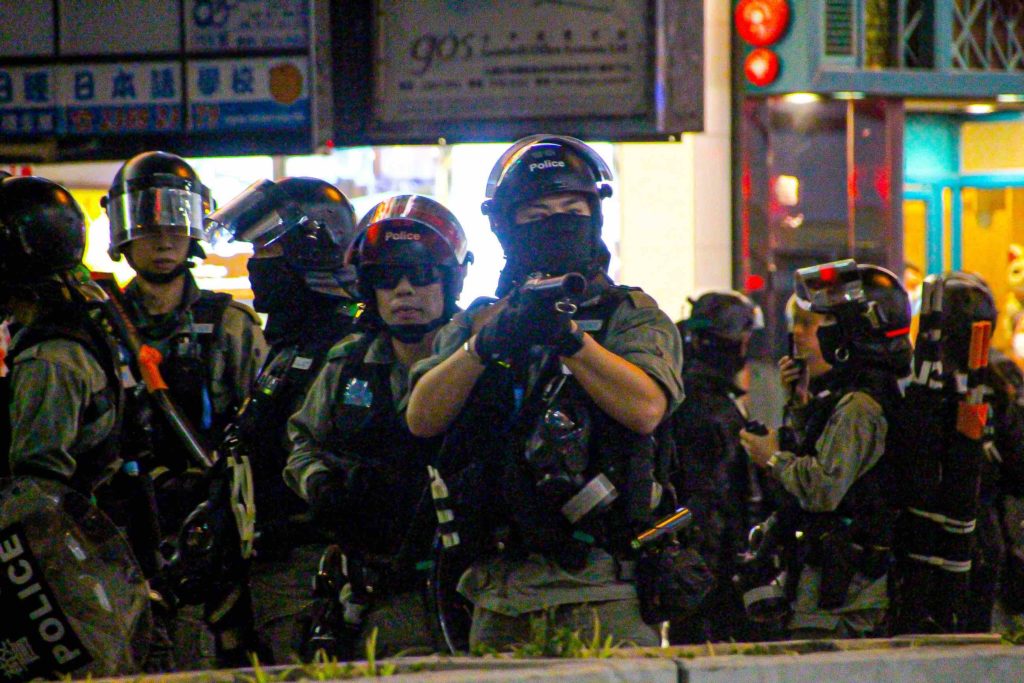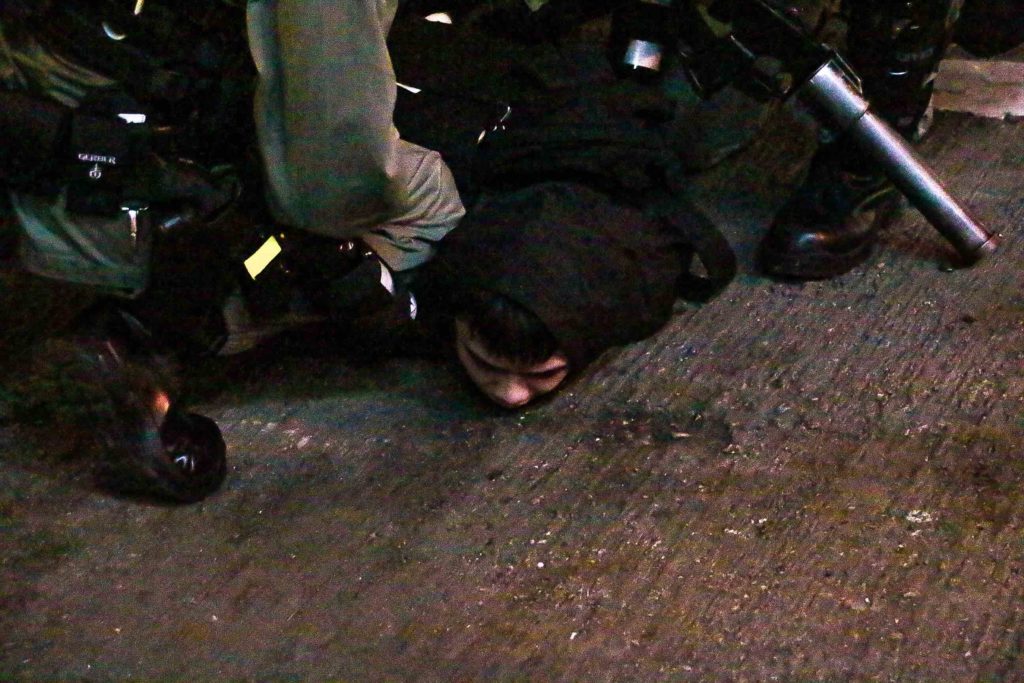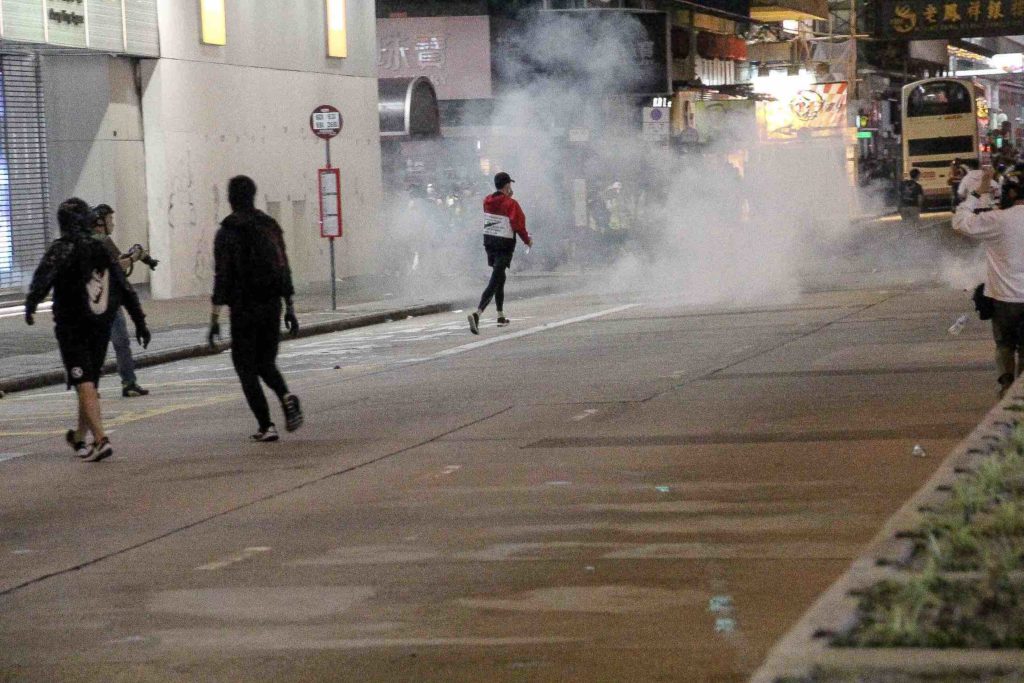After weeks of relative calm, tensions boiled over into violence on Saturday night as Nathan Road in Mong Kok once again became a battleground between angry pro-democracy protesters and Hong Kong police.
Demonstrators had gathered in the area to mark the six-month anniversary of intense August clashes at Prince Edward MTR station, in which so-called “raptor” police units stormed into the station, beating, pepper-spraying, and arresting protesters and commuters as last year’s months-long pro-democracy protest movement wore on.
Unsubstantiated — yet stubbornly persistent — rumors have swirled that protesters were beaten to death at Prince Edward on the night of Aug. 31, despite repeated official denials, and protesters turned the entrance of the station into a makeshift memorial with flowers and other displays for a matter of weeks in the aftermath.
Protesters this weekend had planned to gather for a memorial at 8pm on Saturday, but police turned up to the scene around 6pm, two hours early. Just outside the nearby Mong Kok Police Station, protesters were heard shouting and chanting in reaction to the police presence, setting the tone for the clashes to follow.
Following a pattern that ultimately became routine for much of 2019, the weekend’s protest escalated into a sometimes-violent game of cat and mouse between protesters and police. Protesters erected barricades along a lengthy stretch of Nathan Road, with police turning out in numbers.

As the police sought to disperse the angry crowds with tear gas and pepper spray, roadblocks popped up elsewhere in an apparent effort to stretch the patience and resources of the beleaguered force.
At one point, police were seen apparently retreating along Nathan Road, when a petrol bomb was launched at a nearby police van to cheers from some onlookers. The police responded with a couple of rounds of tear gas, and dispersed a nearby press pack with pepper spray. Since the pro-democracy protests first escalated last year, police have repeatedly been accused of improperly using force against journalists and bystanders.
As the night escalated, further clashes ensued. Most notably, an officer pulled his service weapon and brandished it at oncoming hardliners while under a barrage of thrown projectiles including bottles, bricks, and umbrellas.
At one point, police bottled up protesters, press, and onlookers on a section on Soy Street, leading to even greater commotion and worries of mass arrests. Rubber bullets were fired into the crowd, and pepper spray was also deployed.

Police reportedly arrested 115 in connection with the protest.
As the clashes began to abate, several people could be seen receiving treatment from volunteer first-aiders, mostly for pepper spray.
The return to violent street battles was a surprising change from the recent weeks of calm.
After months of similar scenes playing out across the city last year, the long-running protest movement largely faded into the background beginning in November, following the landslide victory of the pro-democracy camp in local district elections and the U.S. passing the Hong Kong Human Rights and Democracy Act.

The moral victories, combined with the toll taken on frontline protesters during the bruising siege of Hong Kong Polytechnic and other universities, saw the movement much diminished. Over 7,000 people have been arrested since June of last year in connection with protests.
The emergence of the COVID-19 coronavirus outbreak in Hong Kong early this year has also been credited with putting a damper on street protests.
This weekend’s clashes saw fewer black-clad frontliners than many of last year’s protests, and unlike last year, there were no obvious signs of vandalism to mainland-affiliated businesses. The use of petrol bombs was also diminished compared to many of last year’s more intense clashes.

Despite the quieter street presence in recent months, the underlying tensions that grew out of last year’s movement — spurred by an unpopular extradition bill and wide-ranging fears of mainland interference — have not dissipated, with the ongoing coronavirus scare highlighting the lack of trust between the public and the local government.
Medical workers belonging to a union that grew out of last year’s movement went on strike last month in an effort to force the Hong Kong government to fully close the border with the mainland. Though the government closed all but three ports of entry and implemented strict mandatory quarantine measures, it never gave in to calls to shut the border entirely, sparking frustration across the city.
Meanwhile, June — the anniversary of the beginning of the pro-democracy movement — is only three months away, and LegCo elections are slated for September, potentially setting the scene for more confrontations to come.



